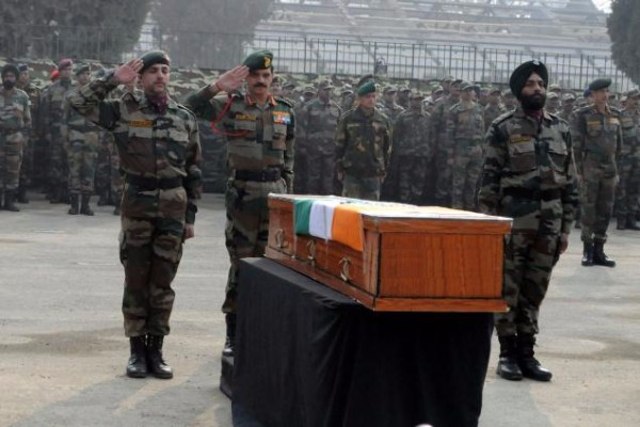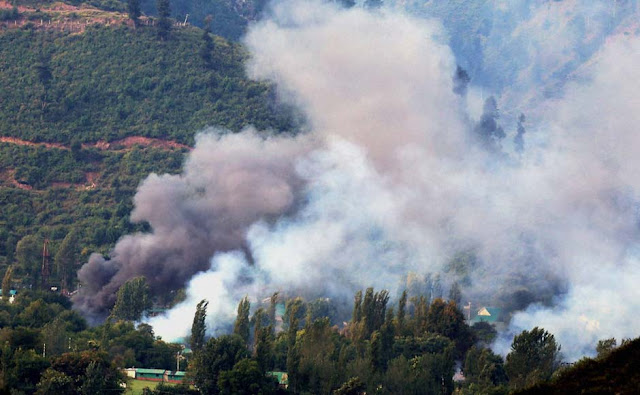The 2016 Uri attack was a terrorist attack by four armed militants on 18 September 2016, near the town of Uri in the Indian-administered state of Jammu and Kashmir. It was reported as "the deadliest attack on security forces in Kashmir in two decades".
At around 5:30 a.m. on 18 September, four terrorists attacked an Indian Army Brigade headquarters at the town of Uri near the Line of Control in a pre-dawn ambush. They are said to have lobbed 17 grenades in 3 minutes. As a rear administrative base camp with tents caught fire, 13–14 army personnel were killed. A gun battle ensued lasting six hours, during which all the four terrorists were killed. An additional 19 - 30 soldiers were reported to have been injured in the attack. Combing operations continued to flush out additional terrorists thought to be alive.
Most of the soldiers killed were from the 10 Dogra and 6 Bihar regiments. One of the injured soldiers succumbed to his injuries on 19 September at R&R Hospital in New Delhi. As of 19 September 2016, total casualties on the military side is poised at 18.
The high casualties are primarily believed due to non-fire retardant transition tents. This was the time of a troops shift, whereby the 6 Bihar regiment was replacing 10 Dogra regiment. The incoming troops were housed in tents, which are normally avoided in sensitive areas around LOC like Uri. The attackers sneaked into the camp breaching heavy security and seemed to know exactly where to strike. Seven of the personnel killed were support staff, including cooks and barbers.

The army personnel recovered a map from the slain terrorists which had markings in the Pashtun language and indicated a detailed plan of action. Four AK-47 rifles and four under barrel grenade launchers along with ammunition were also recovered. As per the army some of the items had Pakistani markings. The Director General of military operations, Lieutenant- General Ranbir Singh, said that there was evidence that the attackers belonged to Jaish-e-Mohammad, an Islamist militant group active in the Kashmir region. He established a hotline contact with his Pakistani counterpart and conveyed India's serious concern on the issue.
Lt. Gen. Ranbir Singh has also stated that the militants used incendiary ammunition to set fire to the tents. Such incendiary material was used for the first time in attacks, according to sources.
The Diplomat noted that the timing of the attack coincided with the Pakistani Prime Minister Nawaz Sharif's visit to New York to address the United Nations General Assembly the following week.
The India Today magazine reported that there was specific intelligence input from the Intelligence Bureau two days earlier that terrorists were planning to strike army formations close to the Line of Control. The intelligence agency had said that three fidayeen squads were launched from Pakistan-administered Kashmir. One of them attacked Uri, another went to Poonch where it was engaged by the security forces, and the third is believed to be targeting Srinagar highway. The India Today Television mentioned that, according to the intelligence sources, Pakistan has plotted a "spectacular event" ahead of Nawaz Sharif's speech to the UN General Assembly.
The National Investigation Agency filed a case regarding the attack took over the investigation on 20 September.
Reactions
India
Prime Minister Narendra Modi and members of his cabinet vehemently condemned the attack, and Home Minister Rajnath Singh held an emergency meeting to discuss further steps to take in response. Minister of Defence Manohar Parrikar and Indian Army cheif General Dalbir Singh visited Kashmir soon after the attack to assess the ongoing military operations and review the security situation in the region. Parrikar instructed the Army to take firm action against those responsible for the attack and also stated that the deaths of the 17 soldiers "will not go in vain". Home Minister Rajnath Singh accused Pakistan for its "continued and direct support to terrorism and terrorist groups", calling Pakistan a "terrorist state" that should be "isolated".
Minister of State for Defence Subhash Bhamre stated that the "entire nation was traumatised" over the death of the 17 soldiers and the whole nation was "united in this hour of grief". He also stated that the Prime Minister, Home Minister and Defence Minister had come to a conclusion that a response needs to be given to Pakistan.
Minster of State for External Affairs and former Army cheif Vijay Kumar Singh stated that India will give a "befitting reply” to the attack. He called upon the Indian Armed Forces to scale up their security and described a cold and calculated response as the need of the hour. He also called for an investigation into the shortcomings which led to the attack while stating that the Army should decide its response "coolly" with proper planning.
Many Indian politicians and public figures have condemned the attack. Former Indian diplomats and foreign policy experts have said that India had been driven to the wall and that a measured and effective response was needed. The opposition party, Indian National Congress, has said that there was no more scope for constructive dialogue with Pakistan.
On 19 September, Rajnath Singh, Manohar Parrikar, Dalbir Singh, National Security Advisor Ajit Doval and officials of Home and Defence ministries met to review the security situation in Kashmir, particularly in areas along the Line of Control.
Later in the same day, India called upon the United Nations Human Rights Council to urge Pakistan to put an end to cross-border infiltration and dismantle the terrorism infrastructure. Since known terrorists like Hafeez Saeed (the chief of Lashkar-e-Taiba) and Syed Salahuddin (the chief of Hizbul Mujahideen) can hold huge rallies in Pakistan's main cities, it said that active support for such terrorists has become the "new normal" in Pakistan. It highlighted that "Zero tolerance" to terrorism is an international obligation.
Pakistan
Pakistan's Foreign Ministry issued statements in which it rejected India's accusations that Pakistan had masterminded the attack. The ministry also condemned India's statements as "vitriolic" and deemed India's stance a "blatant attempt" to deflect attention from human rights abuses in Kashmir. It said the situation in Indian-administered Kashmir was "not of Pakistan's making but a direct consequence of illegal Indian occupation and a long history of atrocities," and that India's reaction of accusing Pakistan without investigations was "deplorable."
Pakistan's Chief of Army Staff Raheel Sharif claimed that India was propagating a "hostile narrative" in response the Uri attack and also stated that the armed forces of Pakistan were "prepared to respond to the entire spectrum of direct and indirect threat”





